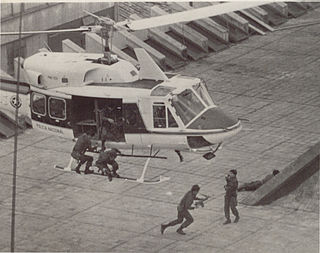
The Palace of Justice siege was a 1985 attack on the Supreme Court of Colombia, in which members of the leftist M-19 guerrilla group took over the Palace of Justice in Bogotá and held the Supreme Court hostage, intending to hold a trial against President Belisario Betancur. The guerrilla group called themselves the "Iván Marino Ospina Company" after an M-19 commander who had been killed by the Colombian military on 28 August 1985. Hours later, after a military raid, the incident had left almost half of the twenty-five Supreme Court Justices dead.
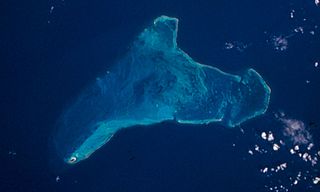
Serrana Bank is a Colombian-administered atoll in the western Caribbean Sea. It is a mostly underwater reef about 50 km long and 13 km wide and has six cays, or islets, the largest of which is Southwest Cay.

El Tiempo is a nationally distributed broadsheet daily newspaper in Colombia launched on January 30, 1911. As of 2019, El Tiempo had the highest circulation in Colombia with an average daily weekday of 1,137,483 readers, rising to 1,921,571 readers for the Sunday edition.
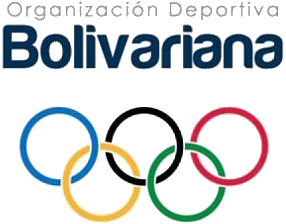
The Bolivarian Games are a regional multi-sport event held in honor of Simón Bolívar, and organized by the Bolivarian Sports Organization. The event is open to athletes from Bolivia, Colombia, Ecuador, Panama, Peru, and Venezuela. In 2010, the ODEBO decided to include Chile as the seventh member of ODEBO. Except Panama, all other participating countries are Andean states.

Nevado del Huila at 5,364 metres (17,598 ft), is the highest volcano in Colombia, located at the tripoint of the departments of Huila, Tolima and Cauca. It is visible from the city of Cali. The andesitic volcano is located on top of the Ibagué Batholith.
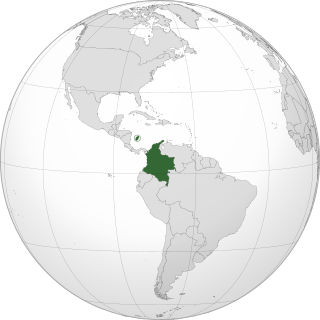
Lesbian, gay, bisexual, transgender, and queer (LGBTQ) rights in Colombia have advanced significantly in the 21st century, and are now quite progressive. Consensual same-sex sexual activity in Colombia was decriminalized in 1981. Between February 2007 and April 2008, three rulings of the Constitutional Court granted registered same-sex couples the same pension, social security and property rights as registered heterosexual couples.
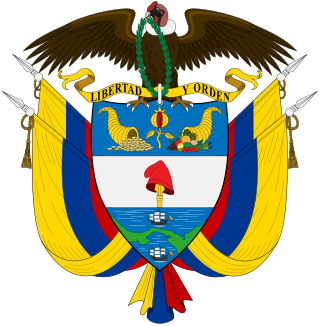
This is a timeline of Colombian history, comprising important legal and territorial changes and political events in Colombia and its predecessor states. To read about the background to these events, see History of Colombia. See also the list of presidents of Colombia.

This is a timeline of events related to the Colombian conflict.

The relationship between the Colombia and Nicaragua has evolved amid conflicts over the San Andrés y Providencia Islands located in the Caribbean Sea close to the Nicaraguan shoreline and the maritime boundaries covering 150,000 km2 that included the islands of San Andrés, Providencia and Santa Catalina and the banks of Roncador, Serrana, Serranilla and Quitasueño as well as the 82nd meridian west which Colombia claims as a border but which the International Court has sided with Nicaragua in disavowing. The sea around the archipelago has been under Colombian control since 1931 when a treaty was signed during US occupation of Nicaragua, giving Colombia control over the area. Both nations are members of the Association of Caribbean States, Community of Latin American and Caribbean States, Organization of American States, Organization of Ibero-American States and the United Nations.

Colombia first formally participated at the Olympic Games in 1932, and has sent athletes to compete in all but one edition of the Summer Olympic Games since then, missing only the 1952 Games. Colombian athletes have won a total of 38 Olympic medals in eight different sports, with weightlifting and cycling as the most successful ones. Colombia is the third most successful South American country at the Olympic Games, after Brazil and Argentina respectively. The Colombian Olympic Committee was created in 1936 and recognised by the International Olympic Committee in 1948.
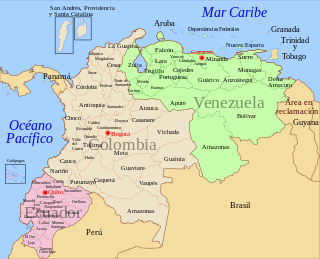
The 2008 Andean diplomatic crisis was a diplomatic stand-off involving the South American countries of Ecuador, Colombia and Venezuela. It began with an incursion into Ecuadorian territory across the Putumayo River by the Colombian military on March 1, 2008, leading to the deaths of over twenty militants, including Raúl Reyes and sixteen other members of the Revolutionary Armed Forces of Colombia (FARC). This incursion led to increased tension between Colombia and Ecuador and the movement of Venezuelan and Ecuadorian troops to their borders with Colombia.
The South American Race Walking Championships is a biennial racewalking competition organized by Atletismo Sudamericano for athletes representing the countries of its member associations. Races for senior men and women, for junior and for youth athletes are featured. In addition, there are separate team competitions. The event was established in 1989 as South American Race Walking Cup, and was occurring annually at first. The 2001 event was held in conjunction with the Pan American Race Walking Cup. The name as well as the frequency of the competition were changed in 2004.
The following is a timeline of the history of the city of Bogotá, Colombia.
The Pacific Ocean Games was a multi-sport event between countries of the Pacific Rim. It was held only once, in 1995 from June 23 to July 3 in Cali, Colombia. Some events were also hosted in the Colombian cities of Buenaventura, Armenia, Pereira, Manizales, Popayán.

Hurricane Iota was a devastating late-season tropical cyclone which caused severe damage to areas of Central America already devastated by Hurricane Eta two weeks prior. The 31st and final tropical cyclone, 30th named storm, 14th hurricane, and record-tying seventh major hurricane of the record-breaking 2020 Atlantic hurricane season, Iota originated as a tropical wave that moved into the Eastern Caribbean on 10 November. Over the next few days, the wave began to become better organized and by 13 November, it developed into a tropical depression north of Colombia. The depression strengthened into Tropical Storm Iota six hours later. The storm was initially impacted by some wind shear, but a center relocation and relaxed shear allowed Iota to quickly strengthen into a hurricane on 15 November, after which it underwent explosive intensification, peaking as a high-end Category 4 hurricane, with wind speeds of 155 mph (249 km/h). After weakening slightly, Iota made landfall in northeastern Nicaragua as a mid-range Category 4 hurricane, becoming the strongest recorded hurricane to make landfall in Nicaragua in November. Iota then rapidly weakened as it moved inland, dissipating on 18 November.
The COVID-19 vaccination program in Colombia is an ongoing effort of mass immunization put in place by the Colombian government in order to respond to the ongoing COVID-19 pandemic. The virus causing COVID-19 was confirmed to have reached Colombia on 6 March 2020. Colombia's preparation and readiness for a vaccine program allowed it to join the first group of countries who received vaccines through COVAX. The first vaccine in Colombia was given to a nurse on 17 February 2021.

Karoll Iván Márquez Mendoza, is a Colombian actor and singer, known for his starring role in the Caracol Televisión soap opera Oye bonita. He is also known for his roles in Un sueño llamado salsa (2010) and Amor de Carnaval (2012).
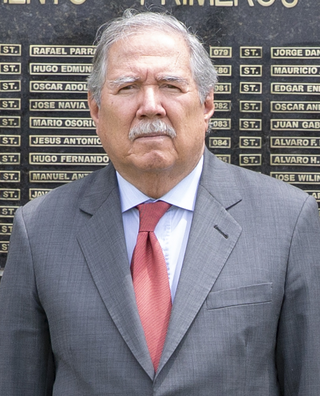
Lorenzo Guillermo Botero Nieto is a Colombian lawyer, businessman, lecturer, and politician. He was appointed as Minister of Defense between 2018 and November 2019.












